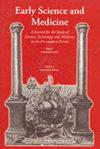中世纪光学、实用几何和天文学中的阴影:托马斯·布拉德瓦尔丁的观点
IF 0.2
2区 哲学
Q3 HISTORY & PHILOSOPHY OF SCIENCE
引用次数: 1
摘要
在研究阴影(本影)在中世纪科学中的作用时,本文分析了一篇迄今未被研究的14世纪早期光学论文,其中包含了最早的透视与透视(PCSU),根据中世纪的证据,这篇论文可能被认为是托马斯·布拉德瓦尔丁(Thomas Bradwardine)的作品。这篇论文的第三部分,关于阴影,提出了三个阴影形状的学说,这一学说在前现代光学和天文学中很流行,对解释日食很重要,以及本影矩形和相反的理论,(co)正切函数的平行,这对(仪器)测量是必不可少的。虽然论文的大部分内容借鉴了John Peckham的Perspectiva communis,但对中世纪天文表的规范,实用几何手册和仪器文本的广泛分析使我们将Campanus的Novara的Practica quadrantis作为PCSU最后一章的主要来源。最后,本文反映了PCSU中体现的光学以光为中心的概念是否可能与前现代光学中主要以视觉为中心的方法相呼应。本文章由计算机程序翻译,如有差异,请以英文原文为准。
Shadows in Medieval Optics, Practical Geometry, and Astronomy: On a Perspectiva Ascribed to Thomas Bradwardine
In examining the roles of the shadow (umbra) in medieval science, this paper analyses a hitherto unstudied early fourteenth-century optical treatise with the incipit Perspectiva cum sit una (PCSU), which, on the basis of medieval evidence, may arguably be attributed to Thomas Bradwardine. The third part of this treatise, on shadows, presents the doctrine of three shadow shapes – a doctrine which was popular in pre-modern optics and astronomy and was important in explaining eclipses – as well as the theory of umbra recta and versa, parallels of (co)tangent functions, which were essential for (instrumental) measurements. While the bulk of the treatise draws on John Peckham’s Perspectiva communis, an extensive analysis of medieval canons to astronomical tables, manuals of practical geometry and texts on instruments leads us to Campanus of Novara’s Practica quadrantis as the chief source of the last chapter of PCSU. Finally, the paper reflects on whether the light-centred conception of optics embodied in the PCSU may echo an alternative current to the otherwise predominantly sight-centred approach in pre-modern optics.
求助全文
通过发布文献求助,成功后即可免费获取论文全文。
去求助
来源期刊

Early Science and Medicine
HISTORY & PHILOSOPHY OF SCIENCE-
CiteScore
0.50
自引率
0.00%
发文量
22
审稿时长
>12 weeks
期刊介绍:
Early Science and Medicine (ESM) is a peer-reviewed international journal dedicated to the history of science, medicine and technology from the earliest times through to the end of the eighteenth century. The need to treat in a single journal all aspects of scientific activity and thought to the eighteenth century is due to two factors: to the continued importance of ancient sources throughout the Middle Ages and the early modern period, and to the comparably low degree of specialization and the high degree of disciplinary interdependence characterizing the period before the professionalization of science.
 求助内容:
求助内容: 应助结果提醒方式:
应助结果提醒方式:


